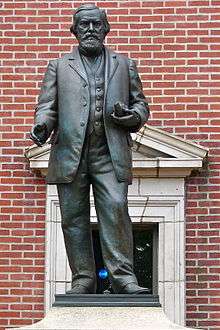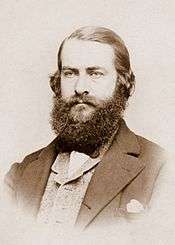Joseph Leidy
| Joseph Leidy | |
|---|---|
|
Joseph Leidy circa 1870 | |
| Born |
September 9, 1823 Philadelphia, Pennsylvania, United States |
| Died |
April 30, 1891 (aged 67) Philadelphia, Pennsylvania, United States |
| Nationality | American |
| Fields | paleontology, anatomy, parasitology |
| Institutions |
Academy of Natural Sciences University of Pennsylvania Wagner Free Institute of Science |
| Notable awards | Lyell Medal (1884) |
|
Signature  | |
Joseph Leidy (September 9, 1823 – April 30, 1891) was an American paleontologist.
Leidy was professor of anatomy at the University of Pennsylvania, and later was a professor of natural history at Swarthmore College. His book Extinct Fauna of Dakota and Nebraska (1869) contained many species not previously described and many previously unknown on the North American continent. At the time, scientific investigation was largely the province of wealthy amateurs.
Paleontology
Leidy named the holotype specimen of Hadrosaurus foulkii, which was recovered from the marl pits of Haddonfield, New Jersey. It was notable for being the first nearly-complete fossilized skeleton of a dinosaur ever recovered.[1] The specimen was originally discovered by William Parker Foulke. Leidy concluded, contrary to the view prevailing at the time, that this dinosaur could adopt a bipedal posture. He also described the holotype specimens of Arctodus (A. simus), the dire wolf (Canis dirus), and the American lion (Panthera leo atrox), among many others.[2]
The noted American fossil collector and paleontologist E. D. Cope was a student of Leidy's, but the enmity and ruthless competition that developed between him and rival paleontologist O. C. Marsh eventually drove Leidy out of western American vertebrate paleontology, a field that Leidy had helped to found. Marsh claimed Leidy contributed to the falling out of the two by showing Cope in the presence of Marsh that Cope had mistakenly placed the head of a fossil Elasmosaurus on the tail, rather than on the neck,[3] and then publishing a correction.[4]
Leidy was an early American supporter of Darwin's theory of evolution, and lobbied successfully for Darwin's election to membership in the Academy of Natural Sciences of Philadelphia.[5]
In 1852 Leidy referred Bison antiquus, the North American fossil bison, to the genus Bison,[6][7]the first to do so.[8] The bison antiquus, sometimes called the "ancient bison", was the most common large herbivore of the North American continent for over ten thousand years, and is a direct ancestor of the living American bison.
Other scientific fields
Leidy was also a renowned parasitologist, and determined as early as 1846 that trichinosis was caused by a parasite in undercooked meat. He was also a pioneering protozoologist, publishing Fresh-water Rhizopods of North America in 1879 - a masterpiece that is still referenced today.[9]
Leidy collected gems as well as fossils, and donated his important collection of the former to the Smithsonian before he died. At Swarthmore, he also taught a class on mineralogy and geology.
Family

Joseph Leidy was born on September 9, 1823, to an established Philadelphia family of German extraction. His father, Philip, was a hatter; his mother, Catharine, died when he was young, during childbirth, whereupon his father remarried to his wife's first cousin, Christiana Mellick. Leidy also had a brother named Thomas Leidy. With the support of his stepmother, and after overcoming the opposition of his father (who wanted him to be a sign painter), Leidy studied medicine at the University of Pennsylvania.[10] He graduated with his medical degree in 1844.
He married Anna Harden, a woman who took a serious interest in his work and helped him with it on occasion.[11] Their marriage was childless, and they eventually adopted an orphaned seven-year-old girl.[12]
Forensic innovator
In 1846, Leidy became the first person ever to use a microscope to solve a murder mystery.[13] A man accused of killing a Philadelphia farmer had blood on his clothes and hatchet. The suspect claimed the blood was from chickens he had been slaughtering. Using his microscope, Leidy found no nuclei in these erythrocytes (human erythrocytes are anucleate). Moreover, he found that if he let chick erythrocytes remain outside the body for hours, they did not lose their nuclei. Thus, he concluded that the blood stains could not have been chicken blood. The suspect subsequently confessed.[13]
Bibliography
His bibliography includes 553 works.[14]
Citations
- ↑ Warren 1998.
- ↑ http://www.ansp.org/museum/leidy/paleo/fossil_species.php
- ↑ Marsh, O. C. (1890-01-19). "Wrong End Foremost". New York Herald. Retrieved 2009-02-02 (web site maintained by M. J. Everhart).. Check date values in:
|access-date=(help) - ↑ Leidy, J. (1870-03-08). "Remarks on Elasmosaurus platyurus". Proc. Acad. Nat. Sci. Phila. Philadelphia: Academy of Natural Sciences. 22: 9–10. Retrieved 2009-02-02 (web site maintained by M. J. Everhart). Check date values in:
|access-date=(help) - ↑ "Joseph Leidy and Charles Darwin". Philadelphia Academy of Natural Sciences web site. Retrieved 2009-09-28.
- ↑ Leidy & 1852a 117.
- ↑ Leidy & 1852b 11.
- ↑ McDonald 1981.
- ↑ "'Fresh-Water Rhizopods of North America', Joseph Leidy, 1879". Xmission.com. Retrieved 2014-07-26.
- ↑ ANSP.
- ↑ ANSPa.
- ↑ "Joseph Leidy: Biographical Timeline: 1874-1891". Philadelphia Academy of Natural Sciences web site. Retrieved 2009-09-28.
- 1 2 Hare, Hobart A. (1923). "Leidy and His Influence on Medical Science". Proceedings of the Academy of Natural Sciences in Philadelphia. 75: 73–87.
- ↑ Chapman Henry C. 1891. Memoir of Joseph Leidy, M.D., LL.D. Proceedings of the Academy of Natural Sciences of America, Academy of Natural Sciences, Philadelphia, 49 pp., pages 31–49.
References
- ANSP, "Joseph Leidy: Biographical Timeline: 1823-1844", Philadelphia Academy of Natural Sciences, archived from the original on May 5, 2010, retrieved 2009-09-28
- ANSPa, "Joseph Leidy: Biographical Timeline: 1823-1844", Philadelphia Academy of Natural Sciences, archived from the original on May 5, 2010, retrieved 2009-09-28
- Leidy, Joseph (1852a), "Bison antiquus", Proceedings Academy of Natural Science, 6: 117
- Leidy, Joseph (1852b), Memoir on the extinct species of American ox, retrieved 20 September 2013
- McDonald, Jerry N. (1981), North American Bison: Their Classification and Evolution, Berkeley, Los Angeles/London: University of California Press, p. 316
- Warren, Leonard (11 October 1998). Joseph Leidy: the last man who knew everything. Yale University Press. p. 320. ISBN 978-0-300-07359-1. Retrieved 20 September 2013.
External links
| Wikimedia Commons has media related to Joseph Leidy. |
| Wikisource has the text of the 1911 Encyclopædia Britannica article Leidy, Joseph. |
- Leidy was the first president of the American Association of Anatomists (1888-1889)
- Works by or about Joseph Leidy at Internet Archive
- Chapman Henry C. 1891. Memoir of Joseph Leidy, M.D., LL.D. Proceedings of the Academy of Natural Sciences of America, Academy of Natural Sciences, Philadelphia.
- Persifor Frazer. 1892 (January). Joseph Leidy, M.D., LL.D. The American Geologist, Philadelphia.
- The Joseph Leidy on-line exhibit at the Academy of Natural Sciences
- The Joseph Leidy Microscopy Portal
- Joseph Leidy at Find a Grave
- View works by Joseph Leidy online at the Biodiversity Heritage Library.
- National Academy of Sciences Biographical Memoir
